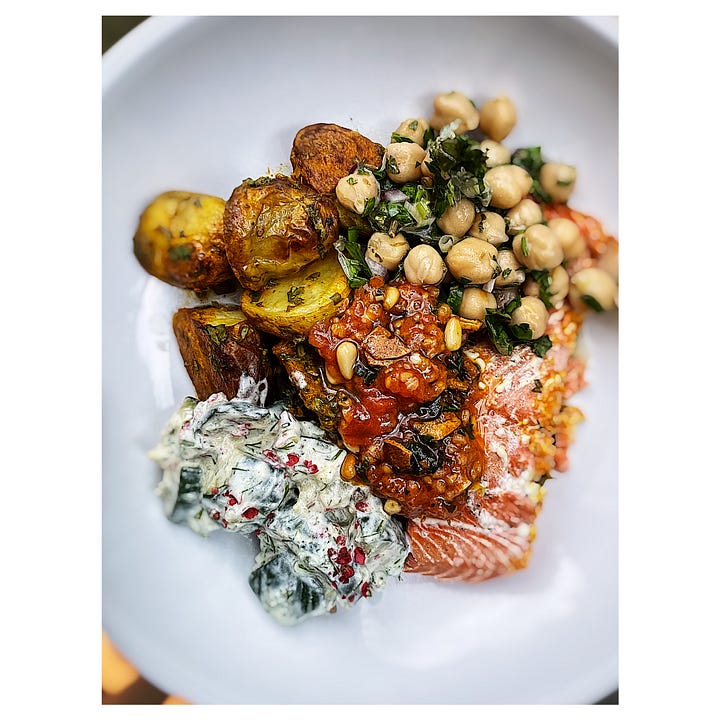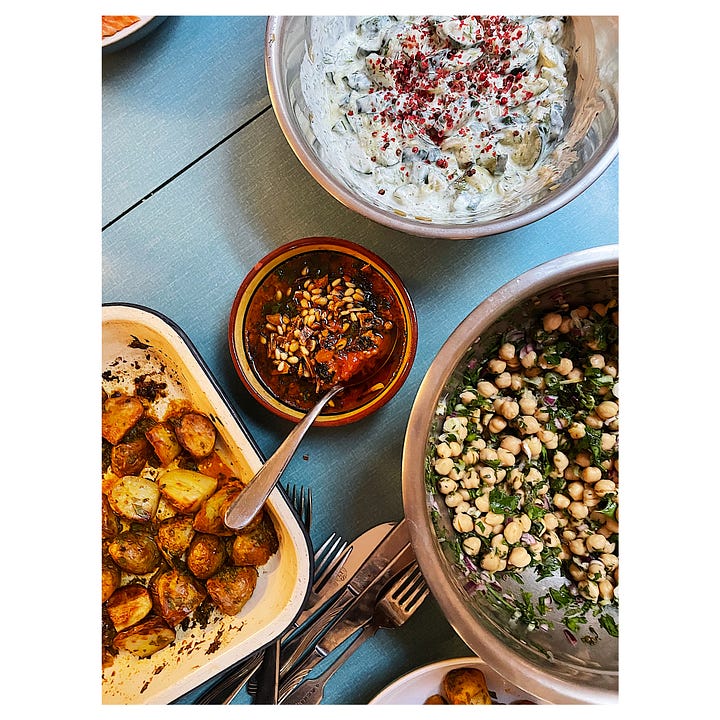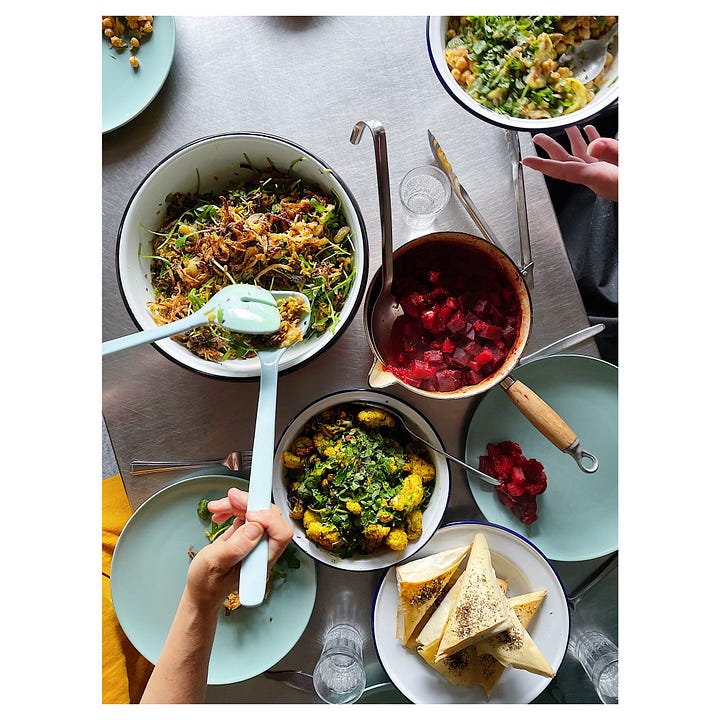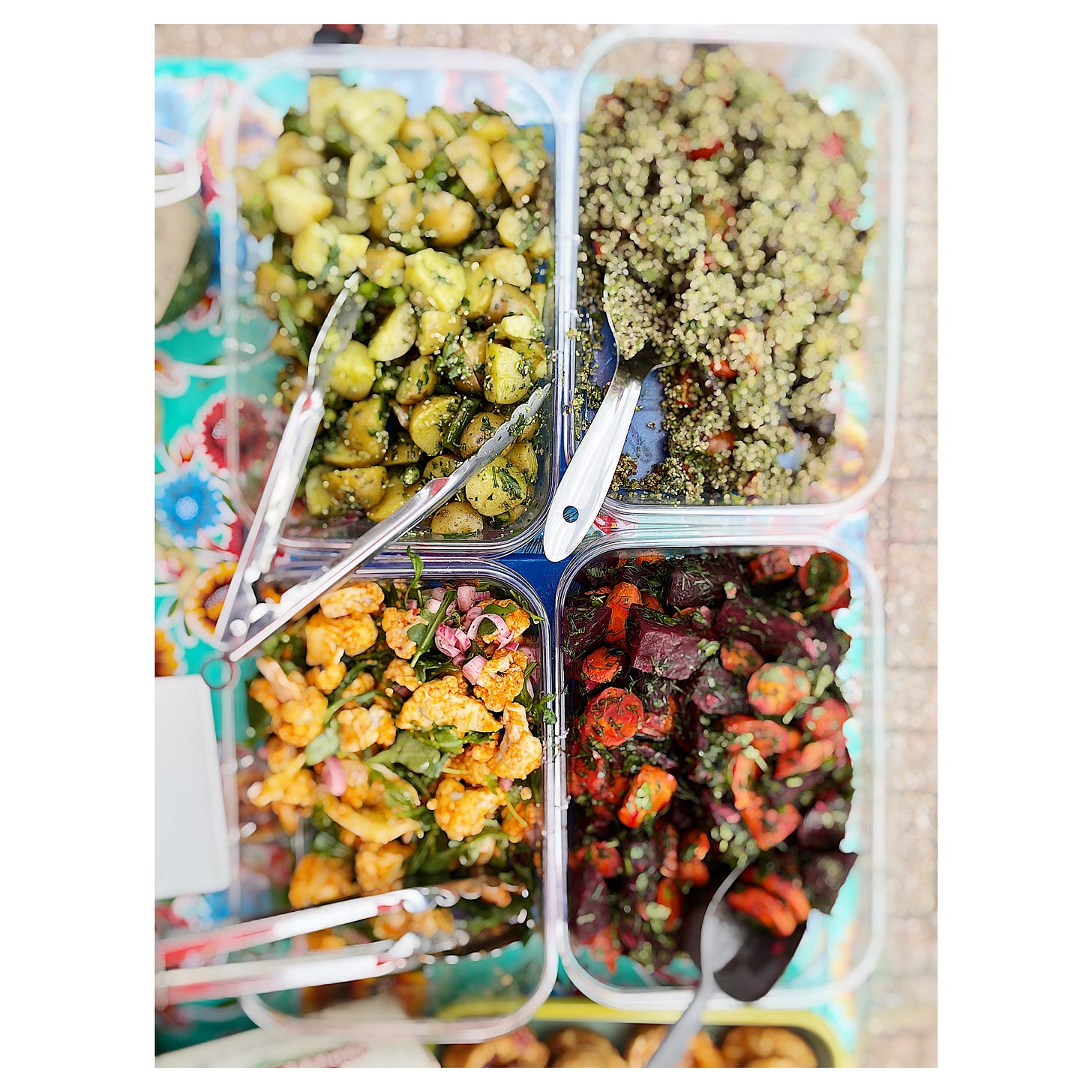Spices Part 4: Spiced Salads
Spices are a great way to add depth of flavour and texture to salads.




Spices can enliven salads throughout the year in so many ways it is honestly hard to know where to begin or how to stop! And so I will begin at what feels like the beginning - with the most obvious and perhaps straightforward way that we add flavour to salad - via a dressing….
When making a simple salad of fresh green leaves, the late great Marcella Hazan would recommend that you first dress the delicate leaves with oil, to give them protection, before then seasoning with salt and pepper before finally adding a dash of vinegar. When salad leaves are abundant, as they are now here in the UK, and if you are fortunate to have easy access to home grown or locally grown fresh lettuce, I personally don’t think that you need much more than this. A stage along is a classic french dressing, which relies on the spiciness of dijon mustard to add depth and tang see here for a lovely piece and recipe by Felicity Cloake in the Guardian. I also love using wholegrain mustard to make dressings, perhaps with a little maple syrup for sweetness or a dash of soy sauce for a salty kick. I often use harissa as a base for a salad dressing, mixing a generous teaspoon or two with extra virgin olive oil and some cider vinegar, sometimes mixing the harissa with a tablespoon of mayonnaise before adding the oil and vinegar if I feel like something creamy as well as piquant.
Miso and tahini are new favourite flavour partners in my kitchen, you never need much miso and can never quite have enough tahini in my opinion! I tend to add a half teaspoon of red miso to a generous tablespoon of tahini, mixed well before adding the other ingredients. As the flavours here are strong I like to use a low flavoured oil like groundnut (peanut) instead of extra virgin olive oil, I also like the dry freshness of a rice vinegar with the miso and tahini, but white wine or apple cider vinegar will do - it is hard for me to give precise direction here as I am very much a chuck it all together and taste it salad dressing maker, but I would say 3 tablespoons of oil to 1 of vinegar to the aforementioned pre mixed miso and tahini. I will include the full recipe below for my Curried Yoghurt Potato Salad, where the flavour is all about the dressing.
Spiced fresh pickles are delightful as an accompaniment to many hot dishes or added as a topper to a salad. A 50/50 water and vinegar brine with a tablespoon of coriander seeds, 1/2 teaspoon ground turmeric, a few chilli flakes to taste and a half tablespoon each of sugar and salt, brought to a simmer and poured over mange toute, sliced and peeled daikon radish, finely sliced beetroot, apples or plums amongst many other things, will make a smashing pickle, with the vegetables ready to serve as soon as the brine has cooled down (pickles are best served fridge cold in my opinion).
Now we move on to ‘sprinkles’ everything highlighted with a live link here will take you to a recipe share on Instagram - these all featured in my torturous 35 day Condiment Challenge, which is being serialised in the local free Lewesian magazine for anyone in my home town. To see a full index of all the recipes I shared follow this link to the Pinterest board I put them all on - gathering the recipes meaningfully in a PDF or some such is on my endless to do list! In the meantime, back to the notion of salad sprinkles, of which there are so very many. I shall move among them by flavour intensity…
Za’atar - there are a number of variations of this blend. My recipe follows the sumac, thyme and sesame formula, but I urge you to do some research into Za’tar as there are many other ways to make it. In Palestine it is most often made with wild herbs called za’atar and akkoub, with olive oil added, so making it more of a paste than a sprinkle. The herbs za’atar and akkoub were declared a protected species by Israel in 1977 and the wild foraging has since been prohibited - this is an enlightening piece of writing on the subject ‘The Struggle for Za’atar and Akkoub: Israeli Nature Protection Laws and the Criminalization of Palestinian Herb-Picking Culture’ by Rabea Eghbariah.
Dukkah means blend in Arabic and is traditionally made with a combination of crushed roasted hazelnuts, sunflower seeds, sesame seeds, cumin, coriander, fennel and sweet paprika. It was introduced over here in the UK in the 90s if my memory serves, most commonly being served with bread and a small bowl of oil at the start of a meal - you dip your bread in the oil and then into the dukkah. My favourite thing to have it with is eggs - boiled, fried, scrambled… It is also lovely on a block of feta that has been generously drizzled with olive oil and lemon juice, sprinkle a good tablespoon of dukkah over the top half an hour or so before eating so that the individual flavours can mingle with the oil, lemon and cheese then break it up over a simple salad of rocket and sliced tomatoes. The recipe shared here is for my Almond Dukkah which has similar notes to the traditional Hazelnut Dukkah but with pumpkin seeds instead of sunflower and smoked paprika instead of sweet.
Toasted seeds add health benefits as well as taste and crunch to salads and are so easy to make. They are also a really fun way to muck about with different flavours - they’re good toasted in a frying pan with a little soy sauce or tamari, or perhaps some garlic salt and onion powder for a salty savoury kick. Here is my recipe for Turmeric and Coconut Toasted Seeds.
Spiced salts are another marvellous way to add a little spicy crunch to food. When making salads you can use a spiced salt as a condiment on the finished salad or you can use the salt to season vegetables, meat or fish that you are roasting to include in a salad…Here is my recipe for Chilli Salt which I really enjoy roasting sweet potatoes with - these make a fabulous warm salad with french beans and a light mayonnaise based dressing.
If chilli is your thing then Gunpowder is a must make for you - think dukkah but with Indian flavour notes and centred around a lightly toasted lentil rather than a nut - delicious sprinkled on some griddled and cooled vegetables such as aubergine and courgettes, perhaps served atop a zingy garlic laced Greek yoghurt.
Dukkahs and salts are lots of fun to make, if a little labour intensive.If you can’t be bothered with the faff of making your own sprinkles, you can always order yourself some of mine here!
We have looked at adding spice to salads just before serving but they can also be used successfully in the initial cooking of components in a salad:
Spiced Rice - Cook rice according to packet instructions but add some spices to the water too. Mejadra is a North African rice dish where the rice is cooked with whole coriander and cumin seeds and ground turmeric, cinnamon and allspice. It is traditionally served hot but I regularly make it for clients and serve it as a salad finished with a pomegranate syrup dressing, pomegranate seeds and either some baby leaf spinach, watercress or rocket. This is a Ottolenghis recipe for Mejadra.
Often I will cook rice with a tablespoon of coriander seeds and a couple of lime leaves, adding a half teaspoon of turmeric to add colour as much as flavour. This makes a gorgeously lemony rice, delicious served hot or cold. As I so often say, with spices don’t be afraid to experiment, you know what you like so let that lead you and get creative if you feel like it!
Carrots roast excellently well with a teaspoon each of cumin, fennel and caraway seeds - as do beetroot for that matter. Cauliflower loves being doused in spices before roasting, with a little oil and lemon to help the flavours along - use any spice blend you know you enjoy but Ras el Hanout and Shawarma work particularly well, mixed with some oil and lemon and rubbed into a whole head of cauliflower, or into ‘steaks’ wedges of cauliflower cut an inch thick. Once again, I urge you to play and experiment! And don’t overlook herbs when cooking with spices as these are a whole extra flavour layer in themselves, which perhaps warrant a piece all to themselves….
Don’t miss my Curried Yoghurt Potato Salad Recipe below.
Happy cooking, and as always if you cook any of the recipes here, I would love to hear how you get on.
Chloe x
Curried Yoghurt Potato Salad
Serves 4
Ingredients
500g waxy potatoes such as charlotte
Olive oil
1 teaspoon mustard seeds
1 teaspoon cumin seeds
2 teaspoons curry powder - I like to use my Madras Curry Powder, but any will do
Bunch of spring onions
150g Greek yoghurt
4 tablespoons olive oil
2 tablespoons cider vinegar
Salt & pepper to taste
Equipment
Large saucepan with a lid
Small frying pan
Colander
Chopping board and sharp knife
Salad bowl and salad servers
Wash and cut the potatoes into evenly sized pieces about 2cm square, cover them in salted water in the saucepan, bring to the boil and cook for 8-10 minutes until they are cooked, testing them before draining to be sure - different potatoes cook at varying lengths of time.
While the potatoes are cooking heat a dash of oil in the frying pan and once hot add the mustard seeds - be careful as they will pop and splutter. Once they are popping add the cumin seeds, stir once before adding the sliced spring onions. Lower the heat and cook for 8-10 minutes until the onions are softened and lightly coloured. Add the curry powder, stir well, add a splash of water and cook for a minute or two until the water has mostly evaporated.
Once the onion mixture is cooked, transfer it into the salad bowl and allow it to cool before making the rest of the dressing.
Once the potatoes are cooked drain them and leave them in the colander over the empty saucepan to allow all the water to evaporate off. I like a warm potato salad but you can cook the potatoes ahead of time and allow them to cool completely before assembling the salad.
When the onion mixture has cooled add the yoghurt and olive oil to the bowl, mixing them together well. Next add the vinegar and salt and pepper to taste.
Add the potatoes to the dressing and mix together well before serving.








love this Chlöe!